new posts in all blogs
Viewing: Blog Posts Tagged with: dummy, Most Recent at Top [Help]
Results 1 - 25 of 45
How to use this Page
You are viewing the most recent posts tagged with the words: dummy in the JacketFlap blog reader. What is a tag? Think of a tag as a keyword or category label. Tags can both help you find posts on JacketFlap.com as well as provide an easy way for you to "remember" and classify posts for later recall. Try adding a tag yourself by clicking "Add a tag" below a post's header. Scroll down through the list of Recent Posts in the left column and click on a post title that sounds interesting. You can view all posts from a specific blog by clicking the Blog name in the right column, or you can click a 'More Posts from this Blog' link in any individual post.

By: Jessica Lanan,
on 5/6/2015
Blog:
Jessica Lanan Illustration
(
Login to Add to MyJacketFlap)
JacketFlap tags:
Illustration,
Blog,
Picture Book,
Process,
Studio,
Dummy,
Final Art,
News and Events,
Thumbnail,
Lee & Low,
Process and Technique,
Add a tag
The art for The Story I’ll Tell is finally done (!) and now in the hands Lee & Low books. It was an exhausting April because I insisted on re-painting several pages that I had already finished in order to improve them. (Changes, in watercolor world, often mean re-doing the whole thing.) Eventually, though, I had to call it quits and just send it off.

Apparently the kitten wishes to be shipped as well.
I can’t wait to see how it will look when it’s all done. So far I’ve seen a preview of the jacket design and couldn’t be more excited to share it with you. Soon… soon.
Even though I don’t have any art to show you now, I do have some fun photos!
First off, the studio. Here’s where the magic happens. I only have the one desk, so I move the drawing board and put the computer there if I’m scanning stuff or doing things online. The board on the wall (far left) is blank now, but it usually holds the book’s latest thumbnails so I can see the whole project at a glance. I update the bulletin boards often for inspiration and reference. The large format scanner is a brand new addition. I feel so professional! (Compare to my studio setup five years ago, which involved a travel watercolor set, a folding camping table, and a hand-me-down PowerBook from 2002. And no scanner whatsoever–I took photos of my paintings back then with a crappy old digital camera.)

The studio, looking tidier than usual.
Sometimes I think that thumbnail drawings are the most important part of the process. They don’t look like much and most of them end up in the reject pile, but that’s where it all starts. I love to draw these while sitting at a cafe.

Too many to fit in the frame.
I make my own dummies at various stages of the process to see how it’s flowing with the page turn.

The cat finds the dummies amusing.
More info about the project should be available soon. I’ll keep ya posted.
I'm doing that 'thing' where I'm juggling lots of little things at once:A few spot illustrations for a dummyPostcard ideasAn IF sketchThumbnails for a new picture book dummyEditing manuscriptsWhen I'm feeling a little scattered, I think this is the best way for me to be productive. I'm not committing 100% to any one thing, but making progress and good use of my time.
Also, I'm completely in love with the mouth/nose shapes on the blue guy in the top right. Swoon! Admit it, we're all selfishly, egotistically, in LOVE with our work from time to time. It makes up for the copious self-loathing we all do.P.S. Have you seen the new, much improved
Illustration Friday website? No? Go now.
Here are a few samples from my latest dummy book, including a detail from one of the color pages. There are two color spreads, and the rest are sketches. The next step is to print out the pages and bind them together to provide a feel of the flow of the book. Once complete, I’ll send off some queries into the universe. I’ll also have a copy of the dummy with me at the SCBWI portfolio showcase in LA in August, so if you’re there, feel free to check out the whole story!
The little girl is my favorite character. She’s always up to something.




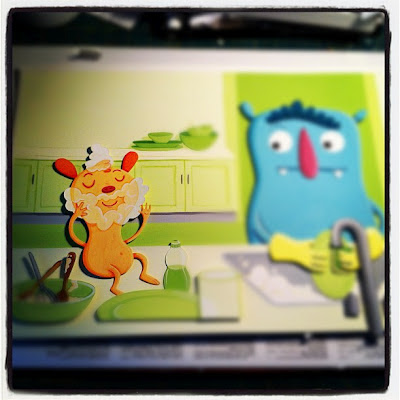 Here's a blurry (instagram'd) version of what's on my desk. I'm currently at a crossroads. I get all squirrely just thinking about it. I had been so confident in my style/process choice for this picture book dummy until yesterday. Now I'm a jiggly mess, unsure of anything. Should I switch to digital? Should I just paint it all over, no collage at all? Should I just finish the digital version I worked on earlier this week? Should I plow forward with what's on my desk, even though there is no CTRL-Z?
Here's a blurry (instagram'd) version of what's on my desk. I'm currently at a crossroads. I get all squirrely just thinking about it. I had been so confident in my style/process choice for this picture book dummy until yesterday. Now I'm a jiggly mess, unsure of anything. Should I switch to digital? Should I just paint it all over, no collage at all? Should I just finish the digital version I worked on earlier this week? Should I plow forward with what's on my desk, even though there is no CTRL-Z?
I thought working on storyboards for another dummy this morning would clear things up a bit. But that's a different book altogether (a board book, actually) which demands a totally different style/process (I think!?!).
See. I'm a little confused.
I know this happens to all of us at times.
I think it has a lot to do with the pressure of the upcoming NESCBWI conference and being signed up for the Portfolio showcase.
I think I'll just sit down and work, and see what happens this time. Isn't that all we can do? Try. Wait. Distract. Think. Ask others. Try again. And in between, breathe.
For the dummy I like to keep the sketches rather loose. I may want to leave a lot of the line work in this one as well. The thick and thin lines add so much movement to the piece. This is one half of a double page so there is no text needed here.
Sometimes we may take on a project that expands in ways we didn't realize beforehand.
At any rate, I will continue with my revision of the original story about the little elephant. As a fold out the number of illustrations has MushROOMEd from 34 pages (including the front and back covers) to around 44 with all the flaps and fold outs. It is fun, and I know I will be happy with the end result.
It is also a LOT of work.
On the bright side, if there is one, *:) work is so slow right now that I have time to give this project my full attention and as I do things are looking better.
Here are some examples of the older version and the newer version. It is a bit softer, more tuned to the youngest market and hopefully more interactive with the fold out surprises I have introduced.
This is the older half finished version.

This is the newer sketch

And this is the newer finished painting.

Although you may not see much difference ... the changes are there. Lighter water with more sparkle and different ears that look more like a real baby elephant's ears. Also I simplified the background. This is actually only one half of a full page spread.

Having sent out my dummy and facing the long wait for any answer...any kind of answer, I have started work on the OTHER story I was working on before this last story crowded its way into my brain.
The sketches for this one are taking a new turn... slightly more of an edge to these. I am not an 'edgy' illustrator, so to you my edge may seem a bit more rounded *:)
This is a study for one of the spreads in the book. I'll spend some time defining the characters and then strive to keep them consistent throughout the book. Occasionally I'll do a thumbnail color study to use as a reference later. Sometimes I toss these out in favor of another color combo.
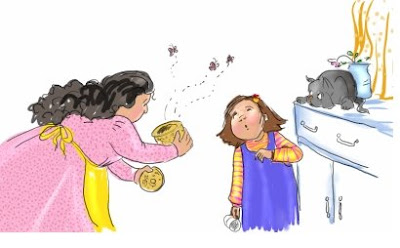
Scientific tidbit:
When an elephant raises it's trunk it is threatening or intimidating a predator or intruder... as if to say.."You better get out of here."
When an elephant lowers it's trunk and runs at you.... "YOU'd REALLY Better Get Out of HERE!"

I am moving very slowly along the last few spreads of my dummy. The story is finished...somewhat. I have a habit of working inside out. That is, I write, then draw then maybe change a word, a line a paragraph, and that affects the drawing a bit.
This way works for me, although it may not seem even sane to others. Having the control over both the manuscript and the illustrations is a blessing and a curse. So far, as one of my artist friends pointed out, there can be multiple changes to a sketch or painting before we see it as done.
This particular sketch depicts two paragraphs from my story and it has changed several times since I first began to visualize the moments and movement. Now I think I am happy. The text changed along with the illustration... as often happens when one has Ultimate Control...but I am moving on to the last three spreads. Maybe by this fall I'll be able to say, Dummy done! Then what?
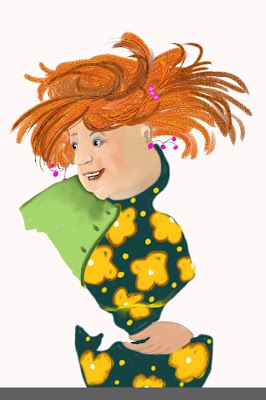
What I am working on now is so much fun! My own story that will soon become a finished dummy and then who knows. Here is a sneak peek at Aunt Tallulah. Her sketch is done and I have only started the painting in Painter X. I have some time now so I am really enjoying every stroke I paint.
Tallulah is an interesting character to work with. She is hospitable, generous, colorful and loves loves loves to bake goodies and serve tea. In fact I would love to go to her house today. Maybe the sun is shining wherever she is! And Yes, she is based on a real life character I knew and loved as a child. Her sister is just as colorful and interesting as she is, and there will be a sneak preview of Beulah in weeks to come.
I usually print out my dummies on fairly good presentation paper. This dummy was a bit different and since the double page spreads were so large I wanted larger paper to print them on. I have good photo paper, but don't want to use that for a dummy. That kind of paper is great and best reserved for a couple of finishes to show to a publisher. But I needed to use larger paper to get the whole spread on one sheet.
So I experimented with papers I had on hand and used a couple of types for printing the dummy. I had a ton of older rag based drawing paper and tried one color copy on that. WOW!
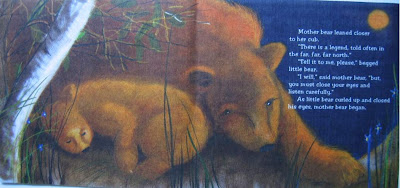
© Ginger Nielson 2009
illustration printed on older drawing paper with a lot of texture
The texture that resulted was something I absolutely loved. Compared to the expensive premium paper that I usually use for a dummy, this paper has such character. I have noticed in some of my favorite picture books that the paper has a wonderful "tooth" to it. This old drawing paper really is "toothy." But it is far to flimsy to use for a dummy.

© Ginger Nielson 2009
illustration printed on good quality matte photo paper
I don't know if it will show up on the blog, but here is the other of the two photos. The presentation paper from Epson is top of the line, but the colors and lines blend a bit too much. The rag paper is not great quality but I loved what it did with the color and the texture. With this print a lot of the texture that I had painted did not show up well. So my search continues.
Somewhere in between these two I will hopefully find the perfect paper for this dummy. And I will find the perfect paper for the finished pieces that I will want to show.
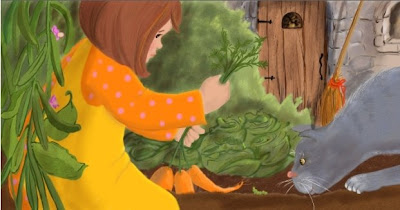
I did decide I wanted to paint the final sketch for this one...but will most likely keep the other illustrations in sketch or line form for the finished dummy. This may or may not be a "good" thing, but right now I have got the TIME to work on this. Illustrators out there will know what I mean for sure. *:)

By:
David Billings,
on 1/27/2009
Blog:
Sparky Firepants Art Blog
(
Login to Add to MyJacketFlap)
JacketFlap tags:
author,
authors,
publishing,
tutorials,
lessons,
how-to,
book dummy,
children's book,
concept,
dummy,
sparkyfirepants,
road trip with rabboit and squash,
road trip with rabbit and squash,
Add a tag
In the world of children’s publishing, there’s a certain methodology to creating a new book. Chronologically, it goes something like this:
- Author writes a book.
- Author mails book to agents and publishers.
- Author files rejection slips.
- Author passes out from shock during phone call from interested party.
- Publisher selects illustrator that fits the manuscript; Author fights for 10-year old niece to do the pictures in crayon and loses.
- Illustrator gnaws hand off during anxiety attack, wondering if he/she is up to the challenge.
- Illustrator makes a dummy.
A dum – wha?
Before the illustrator makes the pretty pictures, he or she makes a preliminary mock-up of the book, called a dummy. Working with the editor, the artist breaks down the manuscript into pages and sketches concepts for possible illustrations. It’s much simpler to sum up in a sentence than it is to do. Humongous thoughts go into the process of creating a book dummy. There are considerations of color, overall tone, character development, logical text breakdown, flow and pace… it’s a huge task.
In fact, to read more about the process, I highly recommend “How to Write, Illustrate, and Design Children’s Books” by Frieda Gates. It’s a comprehensive textbook-style guide to the whole business of creating books for children.
When I created “Road Trip with Rabbit and Squash,” the whole process from idea to completion was about two years (not counting a huge gap year where the MS sat neglected on my Mac). When I got to the point of creating the dummy, I took a very large breath.

Who's the dummy?
I love creating dummies. When I worked on storyboards for TV, I loved breaking down the script into bite-sized chunks and creating the images to go with them. It’s a craft, similar to woodworking or knitting. It’s one of the things I do where I don’t think I would rather be surfing.
My process is very simple and very pre-school. I re-format the manuscript in the computer to manageable chunks of paragraphs. Once I print it out, I cut those sections up and try not to knock them off the desk. Order is good. Part of the process is deciding how many pages you will have, which pages will spread across the gutter (that middle part), and where that last page will go (by itself? hmm…).
I created a small booklet stapling and folding regular copy paper. I knew what size the book and pages would be, so I marked off the pages to the correct scale. From there, I start arranging the cut-out chunks of text across the pages, developing a flow and nice progression through the book. It’s a living process that keeps changing as I work out concepts and adjust the flow. I think about how it will be read both silently and aloud. Does it make sense? Can I put a little cliffhanger in here? Does this page even need text on it or can the picture stand alone? It’s a process that only a slightly insane person would enjoy. And yes, I do. Am. Whatever.
It’s a complex process of thought and impossible to explain. Hey – sort of like writing.
When I was setting up my new studio/office recently, I came across the first dummy copy I made of “Road Trip.” It was buried under a pile of demo reels and chunks of plasticine. I guess I had moved on when I got to the next phase. It was really freaky to see how the first few pages had changed throughout the course of developing the dummy. In the end, I could see why I had made certain choices and I still question others. The photos below give you a tiny glimpse into my secret dummy world:

Pre-school skills come into play. I knew they would come in handy someday.

Here's page 1 as it's published. How did I get here from there? Lots of coffee.
If you want to see more images from the book, they are posted here. If you ask me how I created those concepts, I might even remember.
I have completed work on the most recent version of my picture book dummy!
I've taken some photos of it for you so you can see how it came out as well as some of the steps I took in creating it.

In the above photo, I am pasting the cover art paper to a piece of chip board. I glue-stick one side of the chip board, then carefully line up the cover at on it. I then lay a sheet of parchment or wax paper on top of the cover art and I apply pressure to the board from center to edge, using the bone folder. This helps to avoid any air pockets. I prefer to use glue stick, because it is easy to apply and less messy than other forms of glue. It's easier to control for this type of a project. Plus, if you accidentally apply too much, it will not seep through the paper like a liquid glue might. It would probably just squish out the side while I'm bone-foldering.

Here is a photo of three printed copies of the dummy, along with the tools I used to create a nice, solid cover. (The copies of the dummies above are before assembly.)
The "grey matter" above consists of pages which are titles "copyright/dedication page" and "half-title page". They are place holders for where that actual information would go. It's probably not entirely necessary that my dummy have these blank pages but it's good to show that I'm thinking about it.
 Here is a copy of one unssembled dummy. I printed it myself on my Epson R1800 printer, using Staples matte brochure/flyer paper (for ink jets).
Here is a copy of one unssembled dummy. I printed it myself on my Epson R1800 printer, using Staples matte brochure/flyer paper (for ink jets).
This paper is a very good option if you prefer to print on both sides of the paper, as I do (instead of printing on only one side of a piece of lighter-weight paper and then pasting them together). The brochure paper is hefty enough to withstand printing on both sides. I don't know the weight of the paper, bit it's 8 mil thick.
I included two pages of finished art in the dummy books -- one finished piece for the cover, one for an interior page. These two color pieces were printed on Epson Enhanced Matte paper and then, in the case of the cover it was pasted to the chip board, in the case of the interior page, it was pasted to another page. So, the color inside page is extra thick since it's two pages pasted together, but the Epson paper is better for color art than the Staples brochure paper.
 In this photo, I'm trimming a bit of the paper from the chipboard. The chipboard is slightly smaller than the paper I printed the art on, so I had to do this for every front and back cover.
In this photo, I'm trimming a bit of the paper from the chipboard. The chipboard is slightly smaller than the paper I printed the art on, so I had to do this for every front and back cover.
On the inside of the front and back covers, I pasted a page which says "end papers" to explain what will go there (part of the grey matter").
 Here is a copy of the dummy, back from the copy shop. I chose the "Tape" binding option. Earlier I planned to use the "Velo" binding option but I changed my mind. I'm happy with the "Tape" binding. Came out great!
Here is a copy of the dummy, back from the copy shop. I chose the "Tape" binding option. Earlier I planned to use the "Velo" binding option but I changed my mind. I'm happy with the "Tape" binding. Came out great!
 Here is a picture of an inside spread. See how nice the binding came out from this photo. The "Tape" binding leaves the gutter pretty visible.
Here is a picture of an inside spread. See how nice the binding came out from this photo. The "Tape" binding leaves the gutter pretty visible.
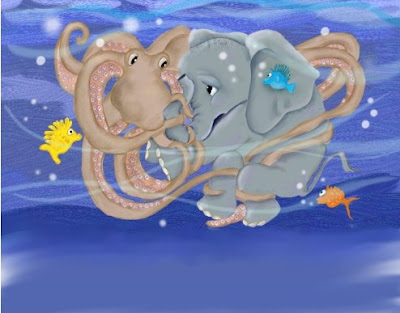
This is a page from the dummy I am working on ... Gunther the Underwater Elephant.

Sturgis, Alexander. 2003. Dan's Angel: A Detective's Guide to the Language of Paintings. Illustrated by Lauren Child. (Published by Kane/Miller.)
Art appreciation. That's what this little book is all about. Mostly. Dan is a young boy who loves a good mystery. Loves being a detective. One day, by chance, he wanders into the art museum. He seems to be awed and a little overwhelmed with all the paintings he sees. He thinks they must tell stories, but he's not sure how to "read" the stories in the paintings. Luckily, he won't be alone on his journey. He first meets the angel Gabriel who steps right out of his painting--"The Annunciation" by Fra Angelico. Gabriel will act as his tour guide and together they will explore the stories of twelve paintings. (Eleven if you don't count "The Annunciation.") By having this dialogue--noting his observations out loud, asking questions, listening, etc.--he is able to grasp the stories of each painting. Other artworks examined include: Belshazzar's Feast by Rembrandt; Andromeda and Perseus by Piero di Cosimo; Madonna and Child with Saints by Campin; The Judgement of Paris by Lorrain; Devi Battles Buffalo Demon Mahisha; The Marquessa de Pontejos by de Goya; Soap Bubbles by Chardin; Venus and Mars by Botticelli; Sunflowers by van Gogh; Weeping Woman by Picasso; and Number 1, 1950 (Lavender Mist) by Pollock.
Overall, I liked it. Definitely one for older kids rather than younger.
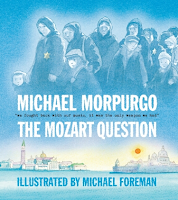
 Morpurgo, Michael. 2008. The Mozart Question.
Morpurgo, Michael. 2008. The Mozart Question.
Don't let appearances deceive you. This book may not look like much. It's a small book after all. But it can pack a "wow" with the best of them. It's not a novel. It's not a picture book. It's definitely for older readers--upper elementary on up. What is it about? Well, even the book starts in a roundabout way.
The question I am most often asked is always easy enough to answer. Question: How did you get started as a writer? Answer: Strangely enough, by asking someone almost exactly that very same question, which I was only able to ask in the first place by receiving a dose of extraordinarily good fortune. I had better explain.
The Mozart Question is a story within a story. The story is framed around that of a reporter--a new reporter hoping for her big break--interviewing a famous musician. The inside story is that of the musician. It is that story that in my opinion is able to pack quite a wow.
Lesley is a new reporter. She's only worked at the paper for a little over three weeks. But when her boss is unable to get the story--get the interview--due to a skiing accident, Lesley takes her place. Her job? To go to the home of Paolo Levi. Her instructions: Don't mess up! And above all else DO NOT ASK HIM THE MOZART QUESTION. The problem? She doesn't know what "the Mozart question" is. So she can only hope that she doesn't ask it accidentally. When she arrives, he tells her she may ask one question. Nervous she goes for it heart and soul,
"I wonder if you'd mind telling me how you got started. I mean, what made you pick up a violin and play that first time?" His answer stuns her, wows her if you will.
I hope you'll read The Mozart Question yourself so you can see just how magical this short, little book really is.
Another (recent) review of
The Mozart Question.

The Mats by Francisco Arcellana and illustrated by Hermes Alegre won the 1995 Philippines National Book Award for Children's Literature. The first American printing was 1999 by Kane/Miller.
The story of The Mats is simple yet powerful. I would say, however, that this picture book would be better for older readers than younger readers. This isn't a toddler and preschool friendly story. As some of the concepts, some of the meaning would be lost. That's just my opinion. Make your own judgment call. But this is as good a time as any to state my philosophy on picture books: NEVER EVER EVER read a picture book aloud to a child (or a group of children as the case may be) without first reading it yourself. Side tangent: Just because a book is packaged as a picture book doesn't mean that it is kid-friendly. There are picture books geared towards adults though they may be disguised and masquerading as a kid's book.
Anyway, back on topic, The Mats is a simple story. A family is waiting for the return of the father. The kids are eagerly awaiting his arrival. They know that he is bringing gifts. He's going to be bringing home a new mat for every member of their family. While they are waiting for his arrival, the narrator feels the audience in on the family's background. We're told about the family's mat. A mat that was a gift to the newlyweds. A mat that is reserved for special occasions. "Mama always kept that mat in her trunk. When any of us got sick, the mat was brought out and the sick child made to sleep on it. Every one of us had at some point in our life slept on it. There had been sickness in our family. And there had been deaths..."
After his arrival, and after the family meal, everyone gathers around to see each mat be presented or gifted. Each mat is to have a name of the family member. The children are told that they cannot use the mats until they are older and go away to the university. But they see that there are three mats remaining.
The revelation or realization that the mats are to memorialize the three sisters (or three daughters depending on your perspective) that had died young is heartfelt and moving. There is sorrow and joy in the remembering.
I liked it. I did. But this would not have been a picture book for me as a kid. I would weep at anything and everything. But I do recommend this book. It is beautifully done. The story was originally a short story.
Francisco "Franz" Arcellana was born in 1916 in Santa Cruz, Manila, the fourth of eighteen children. After studying philosophy at the University of the Philippines, he worked briefly as a journalist before becoming a teacher and a writer of fiction. Collections of his work include Selected Stories (1962), Fifteen Stories: Storymaster 5 (1973) and The Francisco Arcellana Sampler (1990). His stories have been translated into several languages. In 1990 he was declared a National Artist for Literature by President Corazon Aquino. He lives with his wife in Diliman, Quezon City, in the Philippines.
Hermès Alègrè was born in Daet, Camarines Norte in 1968. He set out to become an artist at an early age, drawing pictures on the sand which his playmates would often proceed to erase. Undaunted, he studied art in the Philippine Women's University. After receiving his degree in fine arts, he decided to paint full time. His first picture book, Bahay Kubo, was published in 1993. His work has appeared in over thirty galleries. He lives in Las Pinas, Metro Manila.

Yamada, Utako. 2007. The Story of Cherry the Pig.
Originally published in 2002 in Japan, The Story of Cherry the Pig by Utako Yamada was published in America by Kane/Miller in 2007. It is a story about a pig who loves desserts. The theme of this one is in a way "To thine own self be true." It starts off simply, "Cherry the pig lived in a pretty little village known for its delicate willow treas and sweet, home-grown fruit." It continues, "Now all pigs love to eat, and Cherry was no exception. What she especially loved to eat though, was dessert." She doesn't just love eating desserts. She loves making them--baking them. She loves making people happy; she loves watching people enjoy what she has made. But Cherry's confidence took some time to build. And it was all thanks to a contest--a bake-off--at a local festival. The book is fun and more than a little delightful.

 The Girl with the White Flag: An Inspiring Story of Love and Courage in War Time was written by Tomiko Higa. It was translated into English by Dorothy Britton. It was first published in 1991. One of the more recent reprintings was 2003.
The Girl with the White Flag: An Inspiring Story of Love and Courage in War Time was written by Tomiko Higa. It was translated into English by Dorothy Britton. It was first published in 1991. One of the more recent reprintings was 2003.
First sentence: I was born in Shuri, the ancient capital of Okinawa, which is now part of the city of Naha.
The Girl with the White Flag is the story of the author's childhood in war-time Japan. It begins by giving the reader ample background into the time and culture and place. We meet our heroine, a young girl who throughout the book spans the ages of five through seven. One of the first events she shares with readers is the death of her mother. She then relates what life was like with her father, two older sisters, and her older brother. This portion is hard to navigate. I think in some ways it is just as hard for modern readers to understand the family life--the harshness, the strictness, the discipline, as it is to understand the monstrosities of war and soldiers and starvation. (Or maybe that's just my take on it.)
About halfway through the narrative, the father disappears. He was on his somewhat routine mission of delivering food to the Japanese soldiers, but on this occasion he never returned home. The four children are left to fend for themselves. The American soldiers have just begun their invasion, their battle to capture this island. The children become refugees and the fight to survive has begun. The children ranged in age from 17 to 6. Somewhere along the way, however, two things happen--big things--that make this event even scarier: 1) Their brother dies one night from a stray bullet. 2) Within a few days of burying their brother, our narrator--the six/seven year old girl becomes lost--separated--from her sister.
The book recounts what it was like to be seven and alone and wandering in and out of danger. There was no safe place. Not really. Japanese soldiers weren't "safe." In fact, in her brief encounters with them she was almost killed. No, being near soldiers wasn't safe. The only "safe" soldier was a dead soldier. She did in fact scavenge around the dead soldiers looking for food.
Her will to survive was strong. Her stamina incredible in my opinion. The sights. The sounds. The smells. All surrounded her. Could have potentially traumatized her and paralyzed her into inaction.
If there is power in the Girl with The White Flag it is in its rawness, its simplicity, its boldness when it comes to being straightforward and honest. The story is incredible is powerful because it's true. Here is an eyewitness account of what it means to be seven and a refugee in a war zone. It can be brutal. It can be intense. But there is more to it than that.
127 pages.
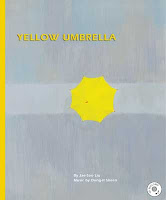
In today's edition of Travel the World, I am featuring Yellow Umbrella by Jae Soo Liu. This book isn't exactly new--the first American edition being published in 2002--and it isn't exactly unknown since it got some high praise when it first released including being named one of the New York Times Best Illustrated books of the year (2002). But it is new-to-me. Or relatively new-to-me.
I first read Yellow Umbrella last fall. I loved it. I really really loved it. But since it is a wordless picture book, I felt somewhat at a loss of what to say. But I've decided to be brave and venture forth into new territory. If my review doesn't do it justice, you'll just have to trust me that it is worth it. Worth finding and reading yourself.
The book Yellow Umbrella comes with a CD. For the full experience, readers are urged to listen to the CD while 'reading' or 'sharing' the book. An interesting concept in my opinion. A wordless picture book whose story is told by music--by melody--and by illustrations. It's a completely different experience than you might expect. It's all about mood and tone. I'm not sure everyone will love it. But I urge you to read and see for yourself. You might just find it as delightful as I did.

The CD is 27 minutes. The track needed for reading the story is a little over 7 minutes long. The rest of the CD are "extra" bits that make it just that much more fun of an experience.
Thoroughly appropriate for use as "art appreciation" or "music appreciation" or the more complex aspects of storytelling. It also makes for a great shared experience on a rainy day.
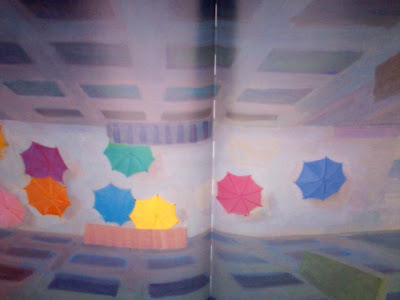
The publisher is Kane/Miller. It was originally published in South Korea.

Last night I reread one of my favorite books of all time. A.A. Milne's Winnie the Pooh. I can't begin to count how many times I've read--either on my own or read aloud--this brilliant book. The characters? Christopher Robin. Winnie ther Pooh. Piglet. Rabbit. Owl. Kanga and Roo. And of course the ever-sullen Eeyore. They're so wonderful. So lovable. So perfect. The language? So beloved. So familiar. So right. I really couldn't imagine a world without Pooh. Pooh captures everything that is so right with the world. The innocence. The charm. The love. The kindness. There's just something so good, so pure about Christopher Robin and his chums.
Here is Edward Bear, coming downstairs now, bump, bump, bump, on the back of his head, behind Christopher Robin. It is, as far as he knows, the only way of coming downstairs, but sometimes he feels that there really is another way, if only he could stop bumping for a moment and think of it. And then he feels that perhaps there isn't. Anyhow, here he is at the bottom, and ready to be introduced to you. Winnie-the-Pooh.
When I first heard his name, I said, just as you are going to say, "But I thought he was a boy?"
"So did I," said Christopher Robin.
"Then you can't call him Winnie?"
"I don't."
"But you said--"
"He's Winnie-ther-Pooh. Don't you know what 'ther' means?"
"Ah, yes, now I do," I said quickly; and I hope you do too, because it is all the explanation you are going to get. (1-2)
Christopher Robin and his stuffed bear, Winnie-the-Pooh, love to be told stories. (I think everyone likes to be told stories.) Pooh especially likes to be told stories about himself because as Christopher Robin says, "he's that sort of Bear."
The first story about Winnie-the-Pooh starts off like this, "Once upon a time, a very long time ago now, about last Friday, Winnie-the-Pooh lived in a forest all by himself under the name of Sanders."
I just love that beginning. Don't you? It's silly; it's fun; it's just right. Once upon a time . . . about last Friday. Genius.
The stories themselves are very interactive. The narrator speaks to the child directly. I really think Pooh is the kind of story that is meant to be read aloud. And read aloud often. It bears much repeating. It only grows better each time it is experienced.
According to the 80th Anniversary edition of the book Winnie the Pooh has been translated into thirty-one different languages! Which makes him perfect for this Wednesday's edition of Travel the World.

By:
Becky Laney,
on 1/16/2008
Blog:
Becky's Book Reviews
(
Login to Add to MyJacketFlap)
JacketFlap tags:
friendship,
war,
YA Historical Fiction,
Jewish,
international literature,
Travel the World,
Jewish Literature Challenge,
Young Adult Challenge,
Printz Award Challenge,
A ~ Z Reading Challenge,
Add a tag
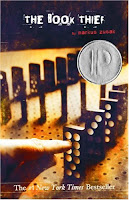
Zusak, Markus. 2006. The Book Thief.
The Book Thief may just be the hardest book I've ever tried to review. It is beautiful. Though it can be ugly. It is intense. It is powerful. It is memorable. The first thing you should know about The Book Thief? It is narrated by Death. This is fitting in many ways since the setting is Nazi Germany during the Second World War. Death is the narrator, and he never lets you forget it. But there are many players--many characters--in the story that Death is relating to his audience all these years later. One of them is a girl, Liesel, and is known by Death as 'the book thief.' These thefts provide some structure to the text. (The structure is one of the odd things about the Book Thief. It isn't chronological. Death doesn't tell a story traditionally. He has his own way of jazzing it up, arranging it so it suits his needs and purposes.) The language, the style, is unique. I think it is written in such a way that you either really love it or you really don't. (It's written in such a way that you could almost open it to any page, and find a sentence or two or a whole paragraph that you want to just lift out and let resonate with you for a time.)
 This is how it begins:
This is how it begins:
First the colors. Then the humans. That's usually how I see things. Or at least, how I try. Here is a small fact: you are going to die. I am in all truthfulness attempting to be cheerful about this whole topic, though most people find themselves hindered in believing me, no matter my protestations. Please, trust me. I most definitely can be cheerful. I can be amiable. Agreeable. Affable. And that's only the A's. Just don't ask me to be nice. Nice has nothing to do with me. (3)
It continues:
People observe the colors of a day only at its beginnings and ends, but to me, it's quite clear that a day merges through a multitude of shades and intonations, with each passing moment. A single hour can consist of thousands of different colors. Waxy yellows, cloud-spat blues. Murky darknesses. In my line of work, I make it a point to notice them. As I've been alluding to, my one saving grace is distraction. It keeps me sane. It helps me cope, considering the length of time I've been performing this job. The trouble is, who could ever replace me? Who could step in while I take a break in your stock-standard resort-style vacation destination, whether it be tropical or of the ski trip variety? The answer, of course, is nobody, which has prompted me to make a conscious, deliberate decision--to make distraction my vacation. 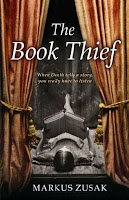 Needless to say, I vacation in increments. In colors. Still it's possible that you might be asking, why does he even need a vacation? What does he need a distraction from? Which brings me to my next point. It's the leftover humans. The survivors. They're the ones I can't stand to look at, although on many occasions I still fail. I deliberately seek out the colors to keep my mind off them, but now and then, I witness the ones who are left behind, crumbling among the jigsaw puzzle of realization, despair, and surprise. They have punctured hearts. They have beaten lungs. Which in turn brings me to the subject I am telling you about tonight, or today, or whatever the hour and color. It's the story of one of those perpetual survivors--an expert at being left behind. It's just a small story really, about, among other things: a girl, some words, an accordionist, some fanatical Germans, a Jewish fish fighter, and quite a lot of thievery. (4-5)
Needless to say, I vacation in increments. In colors. Still it's possible that you might be asking, why does he even need a vacation? What does he need a distraction from? Which brings me to my next point. It's the leftover humans. The survivors. They're the ones I can't stand to look at, although on many occasions I still fail. I deliberately seek out the colors to keep my mind off them, but now and then, I witness the ones who are left behind, crumbling among the jigsaw puzzle of realization, despair, and surprise. They have punctured hearts. They have beaten lungs. Which in turn brings me to the subject I am telling you about tonight, or today, or whatever the hour and color. It's the story of one of those perpetual survivors--an expert at being left behind. It's just a small story really, about, among other things: a girl, some words, an accordionist, some fanatical Germans, a Jewish fish fighter, and quite a lot of thievery. (4-5)
Before the story gets underway, he invites the reader along for the journey:
Yes, often, I am reminded of her, and in one of my vast array of pockets, I have kept her story to retell. It is one of the small legion I carry, each one extraordinary in its own right. Each one an attempt, an immense leap of an attempt--to prove to me that you, and your human existence, are worth it. Here it is. One of a handful. The Book Thief. If you feel like it, come with me. I will tell you a story. I'll show you something. (14-15)
There is depth, substance, to these words, to this story. The descriptions. The details. The powerful sway of the words whether they're describing the beauty of love and family and friendship or capturing the ugly heaviness of hate, anger, and death. It's not an easy story to read. It's full of emotions. It's full of words. It's a book that at it's very heart and soul captures humanity in all its depths--the good, the bad, the ugly. Here is a book that captures what it means to be human.
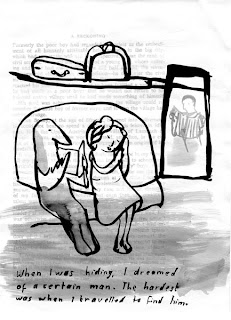 One of the most memorable passages for me (224-236), and I hope this isn't much of a spoiler--is the hand drawn--hand written--portion written by "Max" for Liesel. I find it so powerful in its simplicity. So hauntingly beautiful. There is a second story specially written for Liesel by Max, this second one is found on pps 445-450. This is how that one begins, "There was once a strange, small man. He decided three important details about his life: 1) He would part his hair from the opposite side to everyone else. 2) He would make himself a small, strange mustache. 3) He would one day rule the world." (445)
One of the most memorable passages for me (224-236), and I hope this isn't much of a spoiler--is the hand drawn--hand written--portion written by "Max" for Liesel. I find it so powerful in its simplicity. So hauntingly beautiful. There is a second story specially written for Liesel by Max, this second one is found on pps 445-450. This is how that one begins, "There was once a strange, small man. He decided three important details about his life: 1) He would part his hair from the opposite side to everyone else. 2) He would make himself a small, strange mustache. 3) He would one day rule the world." (445)

Daddo, Andrew. 2007. Goodnight, Me.
Originally published in Australia, Goodnight, Me is a charming bedtime story featuring an orangutan parent and child. The book follows the story of a baby orangutan as he/she is put to bed. First the feet, then the knees, then the tummy, then the bottom, etc. Each part of the body has to be given a sweet and gentle goodnight. For example, Bless you, nose! Can you smell the sleep? and Time to close, eyes. Can you see any dreams yet? The illustrations by Emma Quay and the text by Andrew Daddo are charming and sweet and soothingly gentle. I can easily see this one becoming a child's favorite.

 In today's edition of Travel the World, we are going to visit South Korea. Our book is New Clothes for New Year's Day. The author is Hyun-Joo Bae. The publisher is the fabulous Kane/Miller. In New Clothes for New Year's Day, a little girl--a beautiful little girl--describes for readers what she loves about celebrating New Year's Day. She loves many things, appreciates many things, but most of all she loves the new clothes she receives. She loves getting dressed up and looking her best. It's a simple story about the joy of celebrating life and traditions. The illustrations are nice as well. My favorite feature of the book is the helpful two page spread that discusses the traditional Korean New Year's Day celebrations. One page is text. The other is a diagram and illustration. I definitely recommend this one.
In today's edition of Travel the World, we are going to visit South Korea. Our book is New Clothes for New Year's Day. The author is Hyun-Joo Bae. The publisher is the fabulous Kane/Miller. In New Clothes for New Year's Day, a little girl--a beautiful little girl--describes for readers what she loves about celebrating New Year's Day. She loves many things, appreciates many things, but most of all she loves the new clothes she receives. She loves getting dressed up and looking her best. It's a simple story about the joy of celebrating life and traditions. The illustrations are nice as well. My favorite feature of the book is the helpful two page spread that discusses the traditional Korean New Year's Day celebrations. One page is text. The other is a diagram and illustration. I definitely recommend this one.
View Next 19 Posts























































See? I predicted this would happen in my post last week. *smackshead*
Well, I think it's adorable!
sf
Oh Ggina, we do all go doubts when working. You are not alone. :o)
I am loving what I see already. Not sure how you did it but looks great! I think, if I were you, I would go with a rendering style that I think is fun to do and of course matches the style and feel of the book as well. Try not to think about it too much because things can change later ahead. Just have fun with it and you'll have it ready for the conference.
Remember that a lot can happen after a book is picked up I think and you'll be only finishing a few spreads. What's more important is to have a solid and original book idea and to show how lovely your characters, settings and style are. And you have that! :o)
Il est bon de retrouver vos oeuvres après plus de 6 semaines d'absence... Je rentre tout juste des Philippines...
gros bisous
You have a great idea going here. I find if I put the artwork somewhere I'm not expecting to see it, and then keep passing it on occasion, things jump out at me! Things usually come clear as a result? Or sometimes I have a niggly knowing, which is telling me what to do, Gut instinct? Go with it!!! I can't do the digital thing properly as yet, I imagine the possibilities become mind blowing!
Thank you so much, ladies. Welcome back Martine! Julie - you are right. I love when my eye catches something when I'm just milling about.
I'm feeling better about things today. I think I'm close to finishing it up 'old-school' then moving on. Pheww!